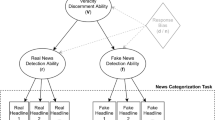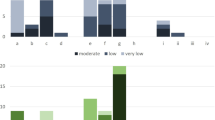Abstract
Effective screening tools are available for many of the top cancer killers in the USA. Searching for health information has previously been found to be associated with adhering to cancer screening guidelines, but Internet information seeking has not been examined separately. The current study examines the relationship between health and cancer Internet information seeking and adherence to cancer screening guidelines for breast, cervical, and colorectal cancer in a large nationally representative dataset. The current study was conducted using data from the Health Information National Trends Survey from 2003 and 2007. The study examined age-stratified models which correlated health and cancer information seeking with getting breast, cervical, and colorectal cancer screening on schedule, while controlling for several key variables. Internet health and cancer information seeking was positively associated with getting Pap screening on schedule, while information seeking from any sources was positively associated with getting colorectal screening on schedule. People who look for health or cancer information are more likely to get screened on schedule. Some groups of people, however, do not exhibit this relationship and, thus, may be more vulnerable to under-screening. These groups may benefit more from targeted interventions that attempt to engage people in their health care more actively.
Similar content being viewed by others
References
United States cancer statistics: 1999-2007 incidence and mortality web-based report [Internet]. U.S. Cancer Statistics Working Group; 2010. [Cited on September 13, 2011] Available from: http://apps.nccd.cdc.gov/uscs/
Screening for Cervical Cancer [Internet]. U.S. Preventive Services Task Force; 2003. Available from http://www.uspreventiveservicestaskforce.org/uspstf/uspscerv.htm
Preventive Services US (2008) Task Force. Screening for colorectal cancer: U.S. Preventive Services Task Force recommendation statement. Ann Intern Med 149(9):627–637
U.S. Preventive Services Task Force (2009) Screening for breast cancer: U.S. Preventive Services Task Force recommendation statement. Ann Intern Med 151(10):716–726, W-236
Smith RA, Cokkinides V, Brooks D, Saslow D, Brawley O (2010) Cancer screening in the United States, 2010: a review of current American Cancer Society guidelines and issues in cancer screening. CA Cancer J Clin 60(2):99–119
Black AT, McCulloch A, Martin RE, Kan L (2011) Young women and cervical cancer screening: what barriers persist? Can J Nurs Res 43(1):8–21
Jennings-Dozier K, Lawrence D (2000) Sociodemographic predictors of adherence to annual cervical cancer screening in minority women. Cancer Nurs 23(5):350–356, quiz 357-358
O'Malley AS, Forrest CB, Mandelblatt J (2002) Adherence of low-income women to cancer screening recommendations. J Gen Intern Med 17(2):144–154
Rigal L, Saurel-Cubizolles MJ, Falcoff H, Bouyer J, Ringa V (2011) Do social inequalities in cervical cancer screening persist among patients who use primary care? The Paris Prevention in General Practice survey. Prev Med 53(3):199–202
Gierisch JM, Bastian LA (2010) Cancer screening adherence. In: Bosworth H (ed) Improving Patient Treatment Adherence. Springer, New York
Joseph DA, Rim SH, Seeff LC (2008) Use of colorectal cancer tests—United States, 2002, 2004, and 2006. Mortal Morb Wkly Rep 57(10):253–258
Subramanian S, Klosterman M, Amonkar MM, Hunt TL (2004) Adherence with colorectal cancer screening guidelines: a review. Prev Med 38(5):536–550
Rim SH, Joseph DA, Steele CB, Thompson TD, Seeff LC (2011) Colorectal cancer screening—United States, 2002, 2004, 2006, 2008. Mortal Morb Wkly Rep 60:42–46
Nelson DE, Kreps GL, Hesse BW, Croyle RT, Willis G, Arora NK et al (2004) The Health Information National Trends Survey (HINTS): development, design, and dissemination. J Health Commun 9(5):443–460, discussion 481-444
Ling BS, Klein WM, Dang Q (2006) Relationship of communication and information measures to colorectal cancer screening utilization: results from HINTS. J Health Commun 11(Suppl 1):181–190
Shim M, Kelly B, Hornik R (2006) Cancer information scanning and seeking behavior is associated with knowledge, lifestyle choices, and screening. J Health Commun 11(Suppl 1):157–172
Hornik R, Parvanta S, Mello S, Freres D, Kelly B, Schwarts JD (2013) Effects of scanning (routine health information exposure) on cancer screening and prevention behaviors in the general population. J Health Commun 18(12):1422–1435
Fox S (2011) Health Topics: Pew Research Center., Available from: http://www.pewinternet.org/2011/02/01/health-topics-2/
Hesse BW, Moser RP, Rutten LJ, Kreps GL (2006) The health information national trends survey: research from the baseline. J Health Commun 11(Suppl 1):vii–xvi
Fox, S. The social life of health information, 2011: Pew Research Center; 2011. Available from: http://www.pewinternet.org/2011/05/12/the-social-life-of-health-information-2011/
Koch-Weser S, Bradshaw YS, Gualtieri L, Gallagher SS (2010) The Internet as a health information source: findings from the 2007 Health Information National Trends Survey and Implications for Health Communication. J Health Commun 15(Suppl 3):279–293
Cline RJW, Haynes KM (2001) Consumer health information seeking on the Internet: the state of the art. Health Educ Res 16(6):671–692
Hesse BW, Nelson DE, Kreps GL, Croyle RT, Arora NK, Rimer BK, Viswanath K (2005) Trust and sources of health information: the impact of the Internet and its implications for health care providers: findings from the first Health Information National Trends Survey. Arch Intern Med 165(22):2618–2624
Rice RE (2006) Influences, usage, and outcomes of Internet health information searching: multivariate results from the Pew surveys. Int J Med Inform 75(1):8–28
Baker L, Wagner TH, Singer S, Bundorf MK (2003) Use of the Internet and e-mail for health care information: results from a national survey. JAMA 289(18):2400–2406
Cantor D, Coa K, Crystal-Mansour S, Davis T, Dipko S, Sigman R (2009) HINTS 2007 Final Report. National Cancer Institute, Rockville
Cantor D, Covell J, Davis T, Park I, Rizzo L (2005) HINTS 2005 Final Report. National Cancer Institute, Rockville
HINTS (2003) 2003 Final Report. National Cancer Institute, Rockville
Screening for Breast Cancer [Internet]. U.S. Preventive Services Task Force; 2002. Available from: http://www.uspreventiveservicestaskforce.org/uspstf/uspsbrca2002.htm
Screening for Colorectal Cancer [Internet]. U.S. Preventive Services Task Force; 2008. Available from: http://www.uspreventiveservicestaskforce.org/uspstf/uspscolo.htm
Muthén LK, Muthén BO (2010) Mplus (Version 6.11) [Software]. Los Angeles
Dobson, AJ (2002) Binary variables and logistic regression In: Dobson AJ. An introduction to generalized linear models, 2nd edition. Chapman & Hall/CRC.; p. 115-131
Susan G. Komen for the cure [Internet]. 2012. [Cited on March 5, 2012] Available from: http://ww5.komen.org/AboutUs/OurWork.html
Glynn RW, Kelly JC, Coffey N, Sweeney KJ, Kerin MJ (2011) The effect of breast cancer awareness month on internet search activity—a comparison with awareness campaigns for lung and prostate cancer. BMC Cancer 11:442
Smith SW, Nazione S, Laplante C, Kotowski MR, Atkin C, Skubisz CM et al (2009) Topics and sources of memorable breast cancer messages and their impact on prevention and detection behaviors. J Health Commun 14(3):293–307
Nelson W, Moser RP, Gaffey A, Waldron W (2009) Adherence to cervical cancer screening guidelines for U.S. women aged 25-64: data from the 2005 Health Information National Trends Survey (HINTS). J Womens Health (Larchmt) 18(11):1759–1768
Preventive Services US (2012) Task Force. Screening for cervical cancer: U.S. Preventive Services Task Force recommendation statement. Ann Intern Med 156(12):880–891
Food and Drug Administration. [Internet]. 2006. Gardasil (human papillomavirus vaccine) questions and answers - Gardasil, June 8, 2006, from http://www.fda.gov/BiologicsBloodVaccines/Vaccines/QuestionsaboutVaccines/ucm096052.htm
Shi L, Lebrun LA, Zhu J, Tsai J (2011) Cancer screening among racial/ethnic and insurance groups in the United States: a comparison of disparities in 2000 and 2008. J Health Care Poor Underserved 22(3):945–961
Berkowitz Z, Hawkins NA, Peipins LA, White MC, Nadel MR (2008) Beliefs, risk perceptions, and gaps in knowledge as barriers to colorectal cancer screening in older adults. J Am Geriatr Soc 56(2):307–314
Blumberg SJ, Luke JV, Cynamon ML (2006) Telephone coverage and health survey estimates: evaluating the need for concern about wireless substitution. Am J Public Health 96(5):926–931
Fahimi M, Link M, Mokdad A, Schwartz DA, Levy P (2008) Tracking chronic disease and risk behavior prevalence as survey participation declines: statistics from the behavioral risk factor surveillance system and other national surveys. Prev Chronic Dis 5(3):A80
Gentry EM, Kalsbeek WD, Hogelin GC, Jones JT, Gaines KL, Forman MR et al (1985) The behavioral risk factor surveys: II. Design, methods, and estimates from combined state data. Am J Prev Med 1(6):9–14
Viswanath K, Kreuter MW (2007) Health disparities, communication inequalities, and eHealth. Am J Prev Med 32(5 Suppl):S131–S133
HINTS. [Internet]. 2012-2013. HINTS Questions. September 12, 2014, from http://hints.cancer.gov/topic.aspx
National Cancer Institute. [Internet]. 2012. Cancer trends progress report – 2011/2012 update, September 12, 2014 from http://progressreport.cancer.gov/doc.asp?pid=1&did=2011&mid=vcol&chid=102
Couper MP, Singer E, Levin CA, Fowler FJ, Fagerlin A, Zikmund-Fisher BJ (2010) Use of the Internet and ratings of information sources for medical decisions: results from the DECISIONS survey. Med Decis Making 30:106S–114S
Fleisher L, Kandadai V, Keenan E, Miller SM, Devarajan K, Ruth KJ et al (2012) Build it, and will they come? Unexpected findings from a study on a web-based intervention to improve colorectal cancer screening. J Health Commun 17(1):41–53
Sequist TD, Zaslavsky AM, Colditz GA, Ayanian JZ (2011) Electronic patient messages to promote colorectal cancer screening: a randomized controlled trial. Arch Intern Med 171(7):636–641
Acknowledgments
This work was supported by the Institute of Education Sciences Pre-Doctoral Fellowship and the National Science Foundation Science Made Sensible Fellowship.
Conflict of Interest
The authors declare that they have no conflicts of interest.
Author information
Authors and Affiliations
Corresponding author
Rights and permissions
About this article
Cite this article
Shneyderman, Y., Rutten, L.J.F., Arheart, K.L. et al. Health Information Seeking and Cancer Screening Adherence Rates. J Canc Educ 31, 75–83 (2016). https://doi.org/10.1007/s13187-015-0791-6
Published:
Issue Date:
DOI: https://doi.org/10.1007/s13187-015-0791-6




